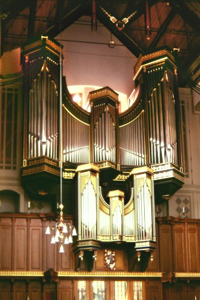
ESSENTIAL RECORDINGS


1- Concert Piece, Op 52a
2- Aria, Op 51
3- Suite modale, Op 43
4- Variationen und Finale über ein altflämisches Lied, Op 20
5- Zehn Orgelchoräle, Op 39
6- Élégie, Op 38
7- Toccata, fugue et hymne sur 'Ave maris stella', Op 28
8- Lied Symphony, Op 66
Flor Peeters was a Belgian organist, composer and teacher. He was born on July 4th, 1903 and died on July 4th, 1986. He was a man of great stature
in his native Belgium where he, in 1971, was bestowed the title of baron. The youngest of nine children to an organist father, he was the only one to display a real
aptitude to music and to eventually follow in his father's footsteps. By the age of 21, he was already a Music Professor and Cathedral Organist, a position he held until his
death at the age of 83. He became a specialist and publisher of early music, and therefore his own music is firmly rooted in polyphony and based on the open Medieval
modes and plainsong.
The Concert Piece, Op 52a, an abbreviated solo organ version of his own Organ Concerto composed during the tragic Ardennes Offensive of 1944, opens
with a bold statement with upward harmonic leaps which lead into a work full of imaginative and well developed ideas, rich colors, and good use of the organ's power.
The Aria, Op 51, in my opinion, is one of the finest examples of this composer's harmonic language and lyrical flair, and the Élégie, Op 38
clearly demonstrates his ability to sustain an idea over a long period of time without falling into tedium, by slowly and methodically building to a well attained climax which
then subsides again just as methodically. A gripping piece dedicated to the memory of his mother who died in 1935. The Zehn Orgelchoräle, Op 39
bring to the forefront his solid grasp of chromatic harmony and counterpoint. How he leads everything to that final tonic chord at the end of 'Nun sei willkommen,
Jesus, lieber Herr' is just as ingenious as any Bach chorale. The Toccata, fugue et hymne sur 'Ave maris stella', Op 28 display his talent for
virtuosity and contrapuntal development. The opening motif of the Fugue is not an easy theme to work with, but Peeters gets it all worked out with apparent ease and
assurance, and the Hymn will rattle your bones with its power and tie everything off nicely at the end with a wonderful harmonic surprise.
This is without a doubt non-liturgucal organ music, to be viewed as pure music, symphonic in nature and meant for concerts rather than church services. Organist
D'Arcy Trinkwon is considered one of today's finest virtuoso organists and makes works like these his specialty. The 1995 Tonbridge School Chapel Marcussen
Organ, with a range of stops from a 1' Piccolo to a 32' Bombarde is well suited to fully meet the demands of this music, and Hyperion has captured
its range of colors with an airy and well distanced recording that takes into consideration the scope and size of the building.
Jean-Yves Duperron - January 2011